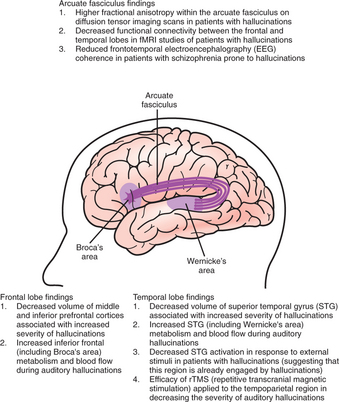

Metabolic and functional abnormalities, particularly in speech and language areas, have been widely reported by positron emission tomography (PET) fluorodexyglucose (FDG-PET) imaging studies of schizophrenia patients with AH. Finally, there have been no studies that investigate structural abnormalities associated with AH in patients with other psychiatric disorders such as affective psychoses. 2 However, it should be noted that these areas are also widely implicated in patients regardless of symptoms 9 and functional associations and can only be inferred from structural imaging data.

Despite some divergence between studies, abnormalities in the auditory cortex and language-related brain regions seem to be the most replicated finding, consistent with evidence from functional neuroimaging studies in AH. This has clear implications for neurocognitive models seeking to explain AH. 1 These studies demonstrate that volumetric changes in networks and regions beyond those involved in speech and language processing are clearly associated with AH. 6 Two VBM studies also report volumetric reduction in parahippocampal gyrus 7 and amygdala 8 supporting the idea that alterations in limbic regions that are important for emotional regulation and processing are associated with AH. 1 In the largest VBM study to date (99 schizophrenia patients with AH), Nenadic and colleagues 5 report an association between AH severity and reduced GMV in the left postcentral gyrus and posterior cingulate, a region thought to facilitate the integration of self-referential stimuli. Single VBM studies have also documented significant effects of AH in nonsensory regions, including the insula, anterior cingulate, posterior cingulate, and inferior frontal gyrus (IFG), thalamus, cerebellum, and precuneus. 4 These findings suggest that aberrations within neural systems involved at different levels of language processing are critical to AH in patients with schizophrenia. A subthreshold effect was also reported in the right STG, thought to be involved in auditory and language processing, particularly of the emotional and prosodic aspect of speech stimuli. Left superior temporal areas are known to be involved in speech perception, particularly the comprehension of the phonological and semantic characteristics of speech. 3 The meta-analysis shows that the “severity” of AH is associated with gray matter reductions in the bilateral STG, including the PAC. 1 Volumetric reductions in temporal regions are confirmed by a recent meta-analysis of 9 VBM studies specifically examining gray matter abnormalities in patients with schizophrenia and AH. Structural imaging studies using region of interest (ROI) and voxel-based morphometry (VBM) techniques have shown that AH are associated with gray matter volume (GMV) reductions in the superior temporal gyrus (STG), sometimes including left PAC, the middle temporal gyrus (MTG), and to a lesser extent in nontemporal lobe regions. We then attempt to synthesize these findings, highlight issues that have interfered with progress, and make recommendations for future research. 1, 2 In the current review, we largely focus on more recent studies and include neurochemical and gyrification studies for the first time. 1 In addition to changes in these speech and language areas, changes to a range of other cortical and subcortical regions are widely reported these findings are detailed in previous reviews.

Early studies established that AH are associated with changes in the anatomy and function in cortical areas responsible for auditory perception (ie, the primary auditory cortex (PAC) and secondary auditory cortex) and speech output (ie, pars opercularis and anterior insular). Neuroimaging studies of auditory hallucinations (AH), particularly in patients with schizophrenia, have allowed researchers to acquire a rudimentary understanding of the brain regions and networks involved in this fascinating but potentially debilitating symptom. The past 2 decades have seen an exponential increase in the use of neuroimaging techniques to examine the neural underpinning of the common symptoms seen in schizophrenia and other psychiatric illnesses.


 0 kommentar(er)
0 kommentar(er)
